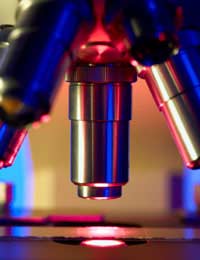Identification of Bacteria

The identification of bacteria is a careful and systematic process that uses many different techniques to narrow down the types of bacteria that are present in an unknown bacterial culture, such as the infected blood of someone dangerously ill with meningitis.
The techniques used at the earliest stages are relatively simple. An unknown sample may contain different bacteria, so a culture is made to grow individual bacterial colonies. Bacteria taken from each type of colony is then used to make a thin smear on a glass slide and this is examined using a light microscope. Viewing the bacteria shows if they are cocci or bacilli or one of the rarer forms, such as the corkscrew shaped spirochaetes.
Gram Staining
Cocci and bacilli can be either gram positive bacteria or gram negative bacteria, depending on the structure of their cell wall. The Gram Stain is named after Hans Christian Gram, a bacteriologist from Denmark who developed the technique in the 1880s. The test is performed on a thin smear of an individual bacterial colony that has been spread onto a glass slide. Gram positive bacteria retain an initial stain, crystal violet, even when the bacterial smear is rinsed with a mixture of acetone and ethanol. The solvent removes the dark blue colour from gram negative bacteria, dissolving away some of the thin cell wall. When a second stain, a pink dye called fuchsin is then added, gram positive bacteria are unaffected by this, as they are already stained dark blue, but the gram negative bacteria turn bright pink. The colour difference can be seen easily using a light microscope.Acid Fast Bacteria
Spirochaetes such as the Mycobacteria that cause tuberculosis and leprosy do not stain well using the Gram Stain. Other stains that do not wash away with dilute acid are used instead. The bacteria are deeply stained, either bright red against a blue background or red against a green background. Because the stain cannot be removed by washing with acid, organisms stained by these methods are termed acid-fast bacteria.Aerobic or Anaerobic?
Finding out whether bacteria are aerobic or anaerobic helps separate them into different categories. It is relatively easy to discover whether a bacterial culture grows in the presence or absence of oxygen. Bacteria that only grow if oxygen is available are called aerobic bacteria. Anaerobic bacteria can grow without oxygen, and some species are killed by oxygen, only surviving in completely oxygen-free environments. These species are described as obligate anaerobes.Enzyme Tests
Within broad types of bacteria, individual species have different metabolic systems and are able to grow using a range of nutrients. Testing bacteria to find out whether they are positive or negative for specific enzymes helps narrow down their identity. For example, Staphylococcus aureus tests positive for the enzyme coagulase, but Staphylococcus epidermidis is negative for this enzyme.Agglutination Tests and Phage Typing
Every individual species of bacterium has a unique collection of 3D shapes on its surface, called antigens. These are formed by the molecules on the outside of the cell wall. When a bacterium infects a human or an animal, the immune system reacts to these antigens, making a specific antibody to each one. Antiserum raised against a known bacterial species can therefore be used to positively identify if that species is present in an unknown culture. A small amount of different antiserum, specific for different bacteria, is used to test a sample. When the result is positive, the bacteria clump together, or agglutinate; when the result is negative, no clumping occurs.The molecules on the surface of the bacterial cell are also targets for bacteriophages (phages for short). These are viruses that infect bacteria and that associate with different bacterial species very specifically. It is therefore possible to identify bacteria by investigating which bacteriophages can bind to their surface.
Protein and DNA Sequencing
In the last 25 years, molecular biology has developed rapidly and it is now possible to sequence the proteins from different bacterial species, make large databases of the sequences, and use them as very powerful identification tools. Similar database have been developed for bacterial DNA and bacterial RNA, particularly the RNA that forms the structural components of bacterial ribosomes.Such techniques are also being used to follow the development of strains of bacterial species that are currently evolving at a very rapid rate. Strains of Chlamydia trachomatis, for example, are known to be exchanging large numbers of genes, forming completely new strains in a very short time. This is worrying – this bacterium is responsible for taking the sight of 8 million people living in developing countries today. Identifying the new strains and studying how they have arisen so quickly is crucial to controlling infection and preventing new cases of blindness.


Re: Friendly Bacteria in the Digestive System
hello, thankyou for this website it was very helpful
Re: Friendly Bacteria in the Digestive System
nope im leaving now goodbye , mumm! crimble crumble ready?
Re: Friendly Bacteria in the Digestive System
The meat out of the bin is perfectly fine jackie!
Re: Friendly Bacteria in the Digestive System
Yeahhh jim not the right time were quite busy at the moment
Re: How Can People Catch Lyme Disease?
My symptoms of Lyme disease occurred in 2017, but was diagnosed in 2019. I had severe symptoms ranging from headache,…
Re: Friendly Bacteria in the Digestive System
kids
Re: Friendly Bacteria in the Digestive System
i like kids
Re: Friendly Bacteria in the Digestive System
I have yo kidz. i have the basement kids
Re: Friendly Bacteria in the Digestive System
oh god im out
Re: Friendly Bacteria in the Digestive System
uhm